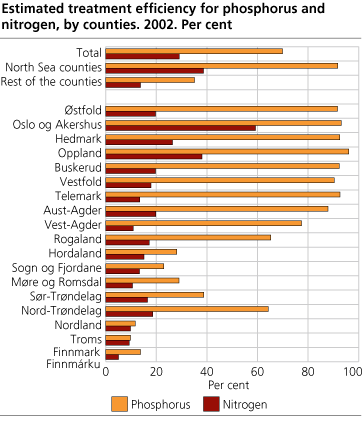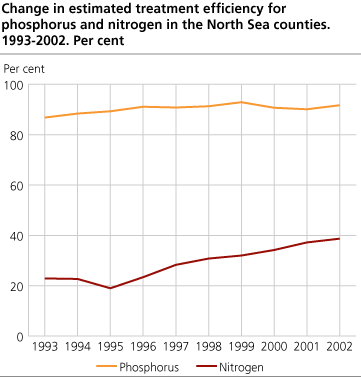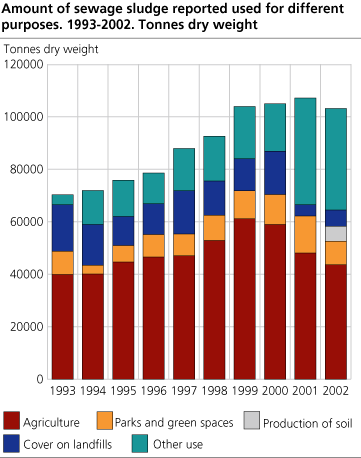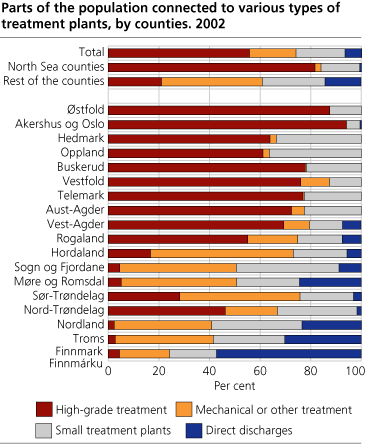Content
Published:
This is an archived release.
Discharges from treatment plants reduced
The removals of phosphorous and nitrogen in Norwegian treatment plants are constantly improving. For the country as a whole, there was registered a decrease in discharges of phosphorous by 9 per cent and 8 per cent for nitrogen, compared to 2001. The part of the population connected to high-grade treatment plants is increasing.
The largest change compared to 2001, was registered in the North Sea counties (Østfold trough Vest-Agder), where the part of the population connected to high-grade treatment plants increased from 77 per cent to 82 per cent.
In 2002 there were registered a total of 2 530 municipal sewerage systems with a capacity of 50 p.e or more. 1 960 of these systems carried out some type of treatment, while 570 discharges wastewater without any treatment. The direct discharges contribute with 23 per cent of the discharges of phosphorous and 11 per cent of the nitrogen from the municipal sewerage plants at 50 p.e. or more. The 2002-statistics reveals that the trend from the 1990s continues, with a continuous improvement on nitrogen removals and a stabilized sufficient removal of phosphorus.
The North Sea counties have the strongest demand for treatment
For 2002, the discharges of phosphorous and nitrogen in municipal sewerage systems are estimated respectively to 725 tonnes of phosphorous and 11 785 tonnes of nitrogen. In the North Sea counties municipal sewerage plants are estimated to discharge 123 tonnes of phosphorous, i.e. 0.05 kilograms per capita. In the other counties the discharges sums up to 602 tonnes of phosphorous, being 0.31 kilograms per capita.
For comparison, in 2001, the North Sea received 1 ton of phosphorous from aquaculture, 106 tonnes of phosphorous from the manufacturing industries, 262 tonnes of phosphorous from agriculture and 218 tonnes from households. The corresponding figures for nitrogen are 9 tonnes from aquaculture, 1 424 tonnes from the manufacturing industries, 10 997 tonnes from agriculture and 7 510 tonnes from households.
and the highest share of connection to high-grade treatment plants.
In the North Sea counties 82 per cent of the population was connected to high-grade treatment plants. In 2001 it was 77 per cent. In the other counties 21 per cent was connected to high-grade treatment plants. In 2001 that percentage was 20.
Same amount of sludge used as fertilizer
For 2002 the municipal reports on sewage sludge show a total of 103 000 tonnes dry weight used for different purposes. This is 8 per cent less than in 2001. In 2002 around 56 per cent of all sewage sludge was used as fertilizer, as it was in 2001, as well.
Tables:
- Table 1 Number of municipal treatment plants, by county. 2002
- Table 2 Discharges of phosphorus, by county and treatment methods. 2002. Tonnes
- Table 3 Discharges of nitrogen, by county and treatment methods. 2002. Tonnes
- Table 4 Disposal of sewage sludge, by county. 2002. Tons dry weight
- Table 5 Content of heavy metals in sewage sludge. The whole country. 2002. Milligrams per kilograms dry weight
Contact
-
Gisle Berge
E-mail: gisle.berge@ssb.no
tel.: (+47) 48 12 19 97




